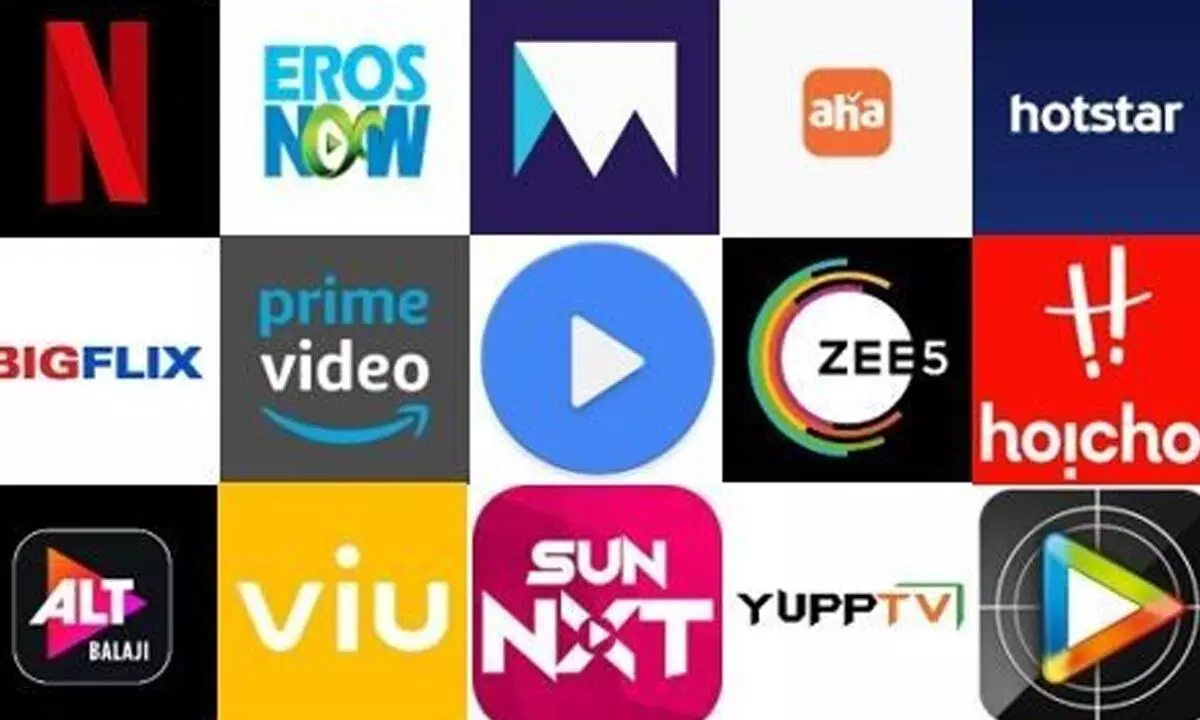The OTT space wars

The OTT space wars
Jio Cinema, or be it Jio mobiles, they specialise in the art of snaring the consumer.
Jio Cinema, or be it Jio mobiles, they specialise in the art of snaring the consumer. Indian companies always seem to be in a hurry to make a place in the market.
If you are competing with just another Indian company providing the same service to you, it is easier, but not in a field that has been pioneered by international players with multiple Indian companies joining in. Jio Cinema started at about the same time when Netflix, Disney+ Hotstar and Amazon Prime entered the Indian market. Through one of its arms, Viacom18. It is one of those mazes the corporate world creates. There is so much hurry to expand when the already acquired or set up enterprises have not even been settled and rooted yet. But the competition is always welcome.
It is not that international OTT platforms such as Netflix and Amazon are minting money in India yet, but a number of Indian OTT content streaming labels have sprung up since. Now, there is a Catch-22 situation here. To attract eyeballs, some new entrants offer free content streaming initially but fail to get the numbers. The audience's mindset is that if it is free, it won’t be worthwhile.
The fact is that ‘content is king’ is a phrase the entertainment industry has believed in since its inception – and it need not be free. If an OTT platform offers what one wants to watch, one will pay for it. That is how the cinemas, stage, and other entertainment media have worked all along.
Looks like Jio Mobile and Jio Cinema are being used to promote each other. Jio mobile was launched in 2017, soon after Jio Cinema. In between, a lot many other OTT platforms have been launched and these include big players such as Sony, Shemaroo, Zee5, MNX, and so on.
Of these, Zee had the inherent advantage of being backed by an array of television channels owned by the group, which, in turn, owned content in many languages, including films (the first draw in India). Similarly, Shemaroo was in the video renting business initially, and later, acquired the video rights distribution business and always made sure it collected the best of the repertoire from top production houses.
Zee and Shemaroo, when they entered the OTT business, possessed ample content. There were some big businesses and media houses that entered the field because it was the thing to do in the name of expansion or, in some cases, not to be left out of the changing world. There are so many OTT platforms today, that one has lost count.
But, talking of Jio Cinema, it has adopted the same disruptive practice it did while launching the JioPhone: free talk time!
To start with, Jio Cinema aired the Indian Premier League (IPL 2023) cricket matches free sans subscription charges while Star Sports held the telecast rights. This could very well have affected the revenues of Star Sports, but what after IPL? An OTT platform is not something a viewer gets addicted to. It is the content that attracts a viewer, even if it is the paid kind.
So what is the company promoting, Jio Cinema, or the JioPhone. Looks like, primarily, it is the phone. The Jio mobiles are priced at between Rs 1,500 and Rs 3,000, and, now, a smart phone comes for around Rs a4,000. But, then, there are dozens of phones that are available in the similar price range.
Considering a lot of people, especially young people, watch all content on a smartphone, the idea seems to be to let the cinema and the phone complement each other. The era of brand loyalty in mobile phones is a thing of the past, save for the loyal iPhone users.
But, using a mobile also involves a degree of snob value. And there are people who won’t buy a mobile that is publicized as being cheap! In the case of JioPhone, the appeal seems to be targeted at the masses and the consumers from moffusil areas.
Fair enough, but there are dozens of mobile phone brands with varied specifications and a layman still trusts the phone vendor rather than the brand when he buys a phone. But all such sundry other brands don’t have free OTT streaming to offer along with the phone.
So what happens? Jio sells some phones and connections, and it offers Bhojpuri content for free, but the idea may meet resistance there. There are already players such as Zee5 and MNX, besides three local players, Yashi Films, Worldwide Records and Enterr10, who have long-time links with Bhojpuri entertainment. Between them, these old players have covered all major hits made so far.
If you are offering free content, it has to have the stuff people want to watch. The Bhojpuri film industry is facing a low phase presently and is not expected to be offering any new worthwhile content to add to the Jio repertoire.
Curious ways of multiplex managers
PVR INOX has announced that it plans to close down about 50 cinemas/screens within the next six months! A lot of cinemas and screens have closed down over a period, especially since Covid-19 struck India. PVR has also dropped some from time to time, but no such formal announcements were made.
So, what was so special about this six-month plan of dropping 50 cinemas? Also, the same announcement also states that PVR INOX will also be adding many more properties with multiple screens!
The reason cited is either that these cinemas are making losses, or that the malls they are attached with have lost their patrons. Are the cinemas counting on malls to bring in people and not the stars and films they screen, or even their own brand? The reasoning is rather corny.
Take for example the PVR-managed property at Versova, Mumbai. The mall is teeming with people and its food court always has more footfalls than any of the screens on the property! Should the reverse logic apply in this case?
Which group is making profit? Despite the Rs 1,000-crore grosser, ‘Pathaan’, in January this year, followed by ‘Avatar: The Way Of Water,’ the cinemas show losses for the first quarter! To the cinema patron it makes no difference. Where this announcement made a difference was with the PVR scrip; it lost Rs 30 the day of the news and Rs 70 the next day!
Meanwhile, PVR INOX made an announcement at 76th Cannes Film Festival. It said: “PVR Pictures, henceforth known as PVR INOX, the largest independent distributor of India of English, foreign language and local films”! PVR Pictures is the distribution arm of the company and joining hands with INOX only makes them the largest cinema chain.
But what, pray, are local films? Do you mean French, for Cannes is in France! Can’t you say Indian films? Also, India has a number of local-language films; all of them have an identity of their own, such as Tamil, Telugu and Kannada, and so on! You are an Indian company and, while Indian films are enjoying international markets since inception, you still remain a local company.
You know, some countries have a law, where you are bound to refer to your country only by name and not as ‘local’ or use a similar term. Say, My Mexico, was how a citizen of Mexico was supposed to refer to his country. When you are making an announcement of this kind, name your country and be proud of it.

















